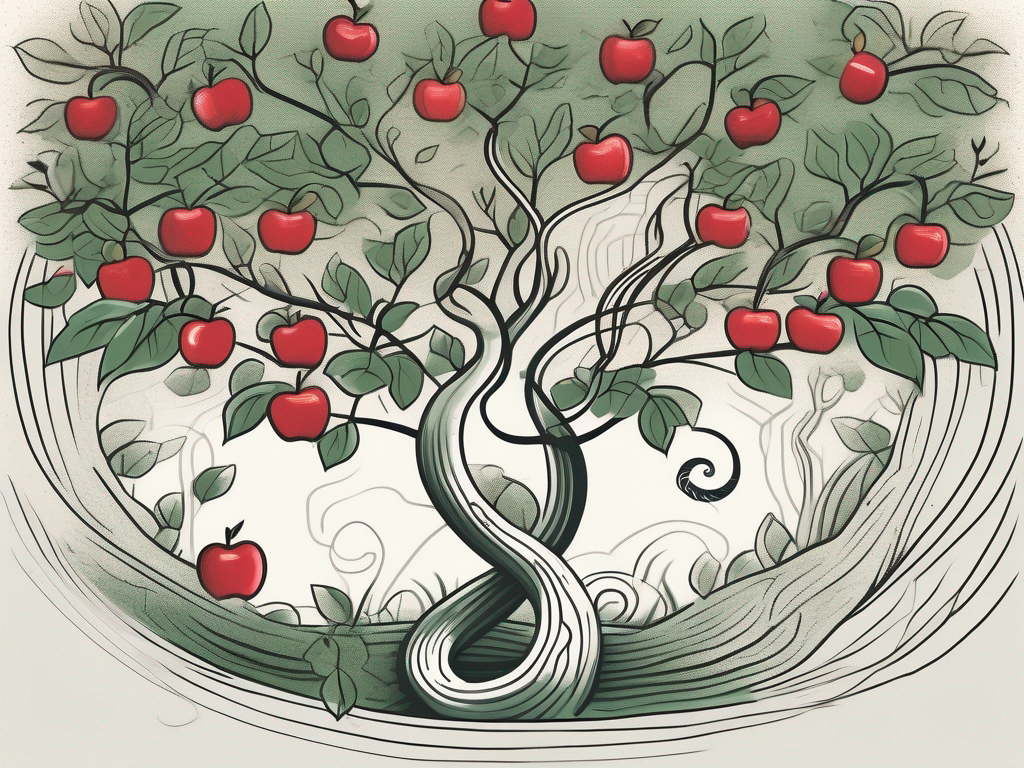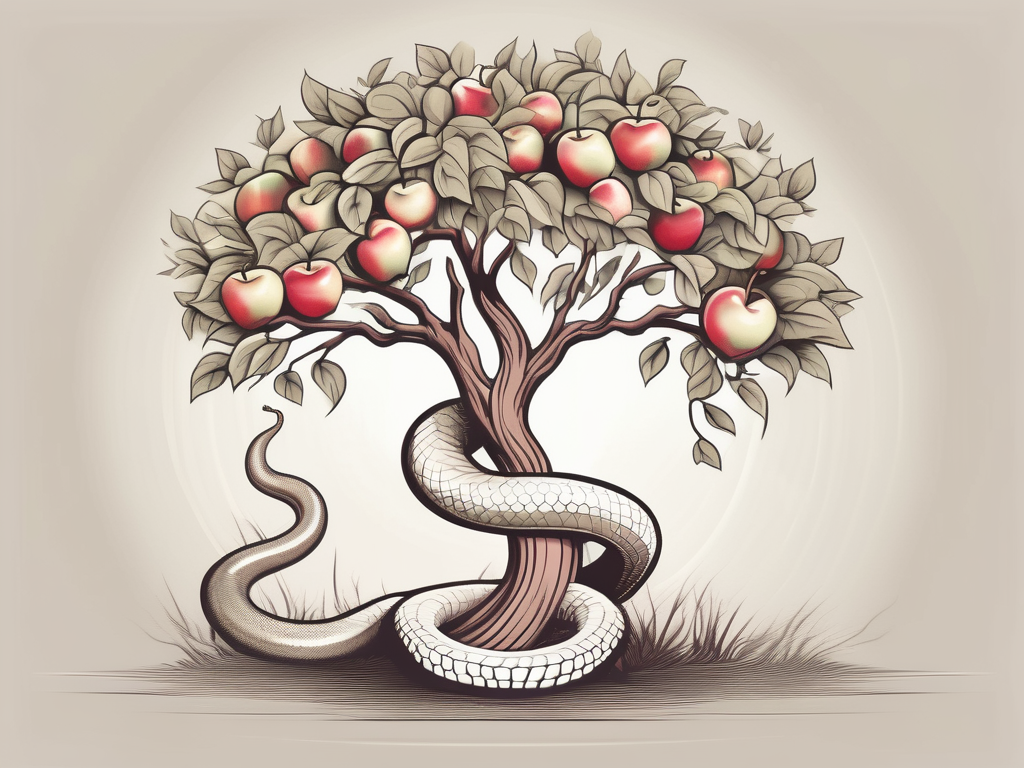Snakes have always fascinated humanity, both in their physical form and in the symbolism they carry. In the Bible, snakes play a prominent role, appearing in various stories and passages. Let’s explore what the Bible has to say about snakes and the rich meanings associated with them.
Understanding the Symbolism of Snakes in the Bible
Snakes have long been associated with certain qualities and concepts within biblical narratives. One of the most well-known stories involving a snake is the tale of the serpent in the Garden of Eden.
The serpent in the Garden of Eden is a captivating story that has intrigued theologians and scholars for centuries. In the book of Genesis, the serpent tempts Eve to eat from the forbidden tree of knowledge. This act leads to the fall of humankind and the introduction of sin into the world. The snake symbolizes temptation and the power of evil, reminding us of humanity’s propensity for disobedience and its consequences.
However, the symbolism of snakes in the Bible goes beyond the story of the Garden of Eden. Another significant narrative involving snakes is found in the book of Numbers, where the Israelites were plagued by venomous snakes as a punishment for their complaining. In a remarkable display of divine intervention, God instructed Moses to craft a bronze serpent and lift it high on a pole. Whoever looked at the bronze serpent would be healed and spared from death. This story can be seen as a symbol of redemption and the power of God’s intervention in times of distress.
Snakes, throughout the Bible, are often associated with evil forces and temptations. They are seen as representations of the devil and his attempts to lead humanity astray. The snake’s slithering nature and venomous bite also contribute to its negative connotations. However, it is important to note that not all references to snakes in the Bible are negative. In some instances, they can also symbolize wisdom and healing, as seen in the story of Moses and the bronze serpent.
The symbolism of snakes in the Bible extends beyond these two stories. In the New Testament, Jesus himself uses the image of a snake to illustrate his impending death and resurrection. In the Gospel of John, Jesus says, “Just as Moses lifted up the snake in the wilderness, so the Son of Man must be lifted up, that everyone who believes may have eternal life.” Here, the snake becomes a symbol of salvation and eternal life through faith in Jesus.
Furthermore, snakes are also associated with the power of transformation and renewal. In some cultures, shedding skin is seen as a metaphor for personal growth and spiritual evolution. Similarly, snakes in the Bible can represent the potential for personal transformation and the shedding of old habits and beliefs.
Overall, the symbolism of snakes in the Bible is multifaceted and rich in meaning. From representing temptation and evil to redemption and transformation, snakes serve as powerful metaphors that invite us to reflect on our own lives and spiritual journeys.
Biblical Passages Referring to Snakes
Old Testament References
Within the Old Testament, there are several instances where snakes are mentioned. These references not only provide insight into the cultural significance of snakes during biblical times but also offer valuable lessons and symbolism.
One notable mention of snakes is found in the book of Exodus. The passage recounts the confrontation between Moses and Pharaoh, during which Moses throws down his staff, transforming it into a snake. This miraculous event serves as a demonstration of God’s power and authority over the Egyptian gods, as the snake was considered a symbol of divine power in ancient Egypt.
Furthermore, the prophet Isaiah also uses snake imagery when speaking about the judgment that will come upon those who have rebelled against God. In Isaiah 14:29, he warns the Philistines of the impending doom they will face, comparing their oppressor to a venomous snake. This metaphor emphasizes the destructive nature of their enemy and serves as a cautionary message about the consequences of disobedience.
New Testament References
In the New Testament, Jesus utilizes snake symbolism in his teachings, drawing upon the rich biblical tradition surrounding snakes. These references not only provide deeper understanding of Jesus’ message but also highlight the continuity between the Old and New Testaments.
One significant instance is when Jesus compares himself to the bronze serpent lifted by Moses in the wilderness. In John 3:14-15, Jesus says, “Just as Moses lifted up the snake in the wilderness, so the Son of Man must be lifted up, that everyone who believes may have eternal life in him.” This comparison symbolizes Jesus’ forthcoming crucifixion and the redemption it brings. Just as the Israelites looked upon the bronze serpent and were healed from the venomous snake bites, Jesus’ sacrifice on the cross offers salvation and eternal life to all who believe in him.
Furthermore, Jesus cautions his disciples to be as wise as serpents and as innocent as doves in Matthew 10:16. This metaphorical instruction highlights the need for discernment and wisdom in navigating the world. Snakes, known for their cunning and stealth, represent the importance of being shrewd and cautious in dealing with the challenges and temptations of life, while doves symbolize purity and innocence.
By incorporating snake imagery into his teachings, Jesus not only engages his audience with familiar biblical references but also imparts valuable lessons about faith, redemption, and the importance of discernment in following God’s path.
Theological Interpretations of Snakes in the Bible
Snakes have long held a significant place in religious and cultural symbolism, particularly in the context of the Bible. The serpent in the Garden of Eden, in particular, has sparked numerous theological interpretations throughout history. Let us explore both traditional and modern interpretations of this intriguing biblical figure.
Traditional Interpretations
Traditionally, the serpent in the Garden of Eden has been interpreted as Satan himself. This interpretation stems from the serpent’s role in tempting Eve to eat the forbidden fruit, leading to the fall of humanity. The serpent is often seen as a symbol of deceit, rebellion, and the temptation to sin. This traditional understanding of the serpent in Eden has had a profound influence on religious teachings and artistic depictions.
Throughout history, the story of the serpent in the Garden of Eden has been used as a cautionary tale, warning against disobedience and the dire consequences it brings. The serpent’s cunning nature and ability to manipulate Eve into defying God’s commandments serve as a stark reminder of the dangers of succumbing to temptation. This interpretation has been a cornerstone of moral teachings, emphasizing the importance of obedience and the need to resist the allure of sin.
Modern Interpretations
In more recent times, there has been a shift in interpreting the serpent in Eden, moving away from the traditional understanding of Satan as the embodiment of evil. Some scholars argue that the serpent should be seen as a symbol of human consciousness and moral awakening.
According to this modern interpretation, the serpent’s actions, although leading to the fall of humanity, triggered a profound transformation in human beings. By consuming the forbidden fruit, Adam and Eve gained the ability to discern between good and evil, thus acquiring moral consciousness. This interpretation emphasizes personal responsibility and the potential for growth and transformation.
Instead of viewing the serpent solely as a malevolent force, this modern interpretation presents it as a catalyst for human development. The serpent’s role in the story becomes more nuanced, highlighting the complexity of human nature and the moral dilemmas we face. It encourages individuals to reflect on their own choices and the consequences they bear, ultimately emphasizing the importance of personal growth and the pursuit of moral understanding.
As with any biblical interpretation, the understanding of the serpent in the Garden of Eden continues to evolve and vary among different religious traditions and scholars. The rich symbolism and theological implications of this biblical figure ensure that it will remain a subject of fascination and contemplation for generations to come.
Snakes in Apocalyptic Literature of the Bible
When exploring the depths of apocalyptic literature in the Bible, one cannot ignore the profound presence of snakes. These slithering creatures, often depicted as symbols of cunning and deception, play a significant role in conveying the epic battle between good and evil. Let us delve into the intriguing world of serpents in biblical apocalyptic texts.
The Serpent in the Book of Revelation
The book of Revelation, with its enigmatic and symbolic language, presents readers with vivid imagery that captures the imagination. Among these captivating images is that of a great dragon or serpent. This formidable snake, described as the ancient serpent who deceives the whole world, represents the ultimate embodiment of evil. Its presence serves as a constant reminder of the enemy that both God and humanity face in their struggle against darkness.
As readers immerse themselves in the apocalyptic narrative of Revelation, they are confronted with the stark reality of an ongoing battle between good and evil. The serpent, with its serpentine allure and cunning tactics, becomes a powerful symbol that encapsulates the relentless fight against malevolence.
Prophetic Visions Involving Snakes
Throughout the Old Testament, prophets frequently employ snake imagery in their visions and prophecies. These prophetic visions, often filled with symbolism and metaphor, serve as warnings and reminders of the spiritual warfare that exists. Through the depiction of snakes, the prophets emphasize the need for vigilance and steadfastness in the face of spiritual challenges.
One cannot help but be captivated by the intricate tapestry of symbolism woven by these prophetic visions. The snakes, with their sinuous movements and piercing gazes, represent the lurking dangers and temptations that threaten to derail the faithful. They serve as cautionary reminders that the path of righteousness is not without its trials and tribulations.
As readers navigate the labyrinthine passages of these prophetic texts, they are encouraged to reflect on the significance of snakes as symbols of both danger and resilience. Just as a snake sheds its skin to embrace a new life, believers are called to shed their old ways and emerge stronger in their faith.
In conclusion, snakes in apocalyptic literature of the Bible hold a multifaceted role. They embody the essence of evil, reminding us of the ongoing battle between good and darkness. They also serve as cautionary symbols, urging believers to remain vigilant in the face of spiritual challenges. The presence of snakes in these texts invites readers to delve deeper into the profound mysteries of faith and the eternal struggle for righteousness.
Snakes in Parables and Teachings of Jesus
The Serpent as a Symbol of Wisdom
In the teachings of Jesus, the serpent symbol is not always negative. In one instance, he encourages his followers to be wise as serpents, suggesting the importance of discernment and shrewdness in dealing with the world’s challenges. This portrayal of snakes as wise creatures invites us to reflect on the multifaceted nature of these creatures.
Snakes have long been associated with wisdom in various cultures and religions. In ancient Greek mythology, the god Hermes carried a staff adorned with two snakes, known as the Caduceus, which symbolized his ability to bring harmony and balance. Similarly, in Hinduism, the serpent god, Shesha, is believed to hold the universe on its hood, representing the cosmic wisdom that sustains creation.
Furthermore, snakes possess remarkable qualities that contribute to their reputation as wise creatures. Their ability to shed their skin symbolizes the concept of renewal and transformation, reminding us of the importance of personal growth and adaptation. Additionally, their keen senses and ability to navigate challenging environments highlight their innate wisdom in survival.
The Serpent as a Symbol of Deception
On the other hand, Jesus also warns about false prophets who come disguised as harmless serpents but are truly ravenous wolves. This cautionary message reminds us to be wary of those who seek to mislead and deceive us. It calls for discernment and the need to test the teachings we encounter.
The association between snakes and deception can be traced back to the story of Adam and Eve in the Garden of Eden. The serpent, often identified as Satan, cunningly manipulates Eve into disobeying God’s command, leading to the fall of humanity. This biblical account serves as a powerful reminder of the consequences of succumbing to deceit and the importance of remaining vigilant against false teachings.
Interestingly, the serpent’s ability to deceive is not limited to biblical narratives. In the natural world, certain snake species employ camouflage techniques to blend seamlessly into their surroundings, enabling them to ambush unsuspecting prey. This remarkable adaptation highlights the deceptive nature of snakes and serves as a metaphor for the dangers of being misled.
In conclusion, the Bible portrays snakes as powerful symbols, representing both the potential for evil and the opportunity for redemption. From the serpent in the Garden of Eden to the apocalyptic imagery in the book of Revelation, snakes remind us of the ongoing spiritual struggle between good and evil. As we reflect on these biblical tales and teachings, let us strive for wisdom and discernment in navigating the complexities of life.












